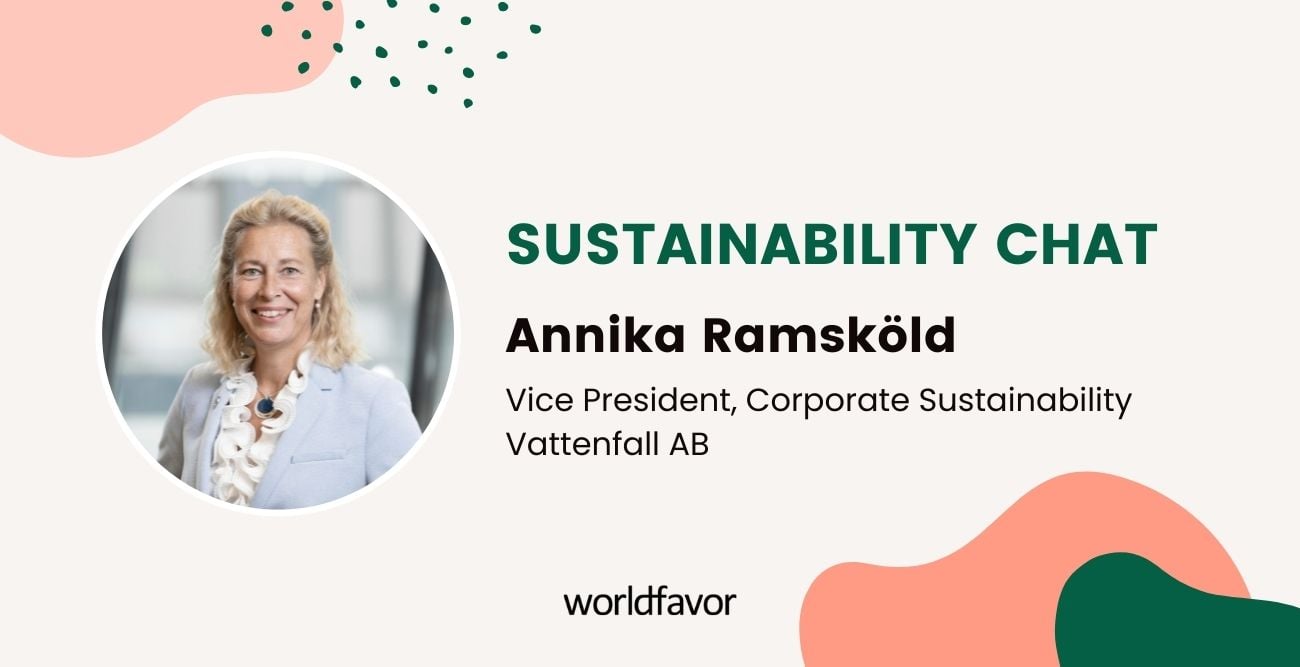Sustainability Chat with Annika Ramsköld, VP, Corporate Sustainability at Vattenfall AB
In our Sustainability Chat series, we speak with leaders and dreamers in the world of sustainability – picking their brains on what drives them, their experiences working in the field, plus all the best tricks of the trade.

In this episode of the Sustainability Chat, we are honored to talk to Annika Ramsköld, Vice President Corporate Sustainability at Vattenfall AB – one of Europe's largest producers of electricity and heat. Climate challenges define Vattenfall's work and their main goal is to enable a fossil-free life within a generation. Join our conversation with Annika and learn more about how energy is being produced in Sweden, how we can get rid of fossil fuels and how the Vattenfall Innovation Project contributes to a greener future.
What does a typical workday look like for you?
– No day is like another with one exception – all of them are filled with meetings from early morning until the workday ends. Sometimes I work on my own in the evenings – I prepare presentations, strategic documents, review decision material, answer emails, etc. As head of Sustainability, I have the privilege of interacting basically with everyone at Vattenfall - all the way from our stakeholders, customers, suppliers, investors, to our employees and different management teams. During the meetings, I present the latest trends and share important benchmarks and assessments. We discuss, challenge and propose how we can improve our ways of working, so we can integrate sustainability even further, stretch our targets and ambitions. I also sit in many SteerCos and boards, where we set the overall strategy and ensure that our decision-making is in line with our strategy, targets and external expectations.
What main sources of energy do you use at Vattenfall?
– For our electricity generation, the two biggest sources are hydro and nuclear power. There is also wind and solar power which grow rapidly, and then there is gas. Coal is almost completely phased out for electricity generation. For our district heating, gas is Vattenfall’s biggest source together with waste and biomass, while coal is about to be phased out by 2030, if not earlier.
.jpg?width=1300&name=Sustainability%20Chat%20Annika%20Graphs%20(5).jpg)
Source: Vattenfall
How can we all contribute to phase out fossil fuels faster?
– We can all make the right choices, for example by asking for and buying only fossil-free electricity, heat, transportation and other services and products. We can choose an electric vehicle and minimize air travel. We can also be open to buying renewable energy from local providers. It would both be more efficient and sustainable to use resources that are produced close to where we live. As companies, we can set clear science-based targets, put firm requirements in our tenders and purchase low-carbon or fossil-free goods and services.
"As companies, we can set clear science-based targets, put firm requirements in our tenders and purchase low-carbon or fossil-free goods and services."
A fossil-free living within one generation – could you tell us more about the Vattenfall Innovation project and its progress?
– To enable fossil-free living means to identify and bring new fossil-free solutions and technologies to the market. We see great progress in many areas. One example is the partnership Hybrit formed by SSAB, LKAB and Vattenfall – we have built a pilot plant that produces fossil-free steel which is already being delivered to our customers, for example, Volvo. We are also a founding member of the First Mover Coalition, which is aimed at creating demand for the transformative solutions that currently are in the pilot phase, like fossil-free steel. We have many partnerships that already deliver fossil-free solutions and many are in the progress. We also work closely with organizations like WindEurope, so we can speed up the development by creating new demands and using our buying power jointly.
What does the future of renewable energy look like in Sweden and the rest of the world?
- Sweden already has electricity that to 98% is fossil-free thanks to hydro and nuclear power. As sectors like transports and heavy industry start to transform away from fossil fuels, more electricity will be needed in the future. To meet this demand, we should focus on a growing share of wind and solar capacity. In Europe, wind power is growing quickly. Onshore wind constructions nowadays are more and more combined with solar panels and batteries to make better use of the land and the infrastructure. The growth of solar power is very important worldwide, especially in countries with a lot of sun – and right now, we are missing opportunities for both individual households and companies to generate their own electricity. However, solar capacity is expected to increase three times to 2025 and five times to 2030, and the world’s wind capacity is estimated to increase three times until 2030 (see graph below).
.jpg?width=1300&name=Sustainability%20Chat%20Annika%20Graphs%20(7).jpg)
Source: Vattenfall
If you liked this Sustainability Chat and want to stay updated on our future guests, please subscribe to our newsletter. We can guarantee exhilarating chats with sustainability profiles you don’t want to miss!
Related blog post you might like:





%20as%20the%20deadline%20approaches.%20Learn%20about%20compliance%20requirements%2c%20potential%20delays%2c%20and%20key%20updates..png)

